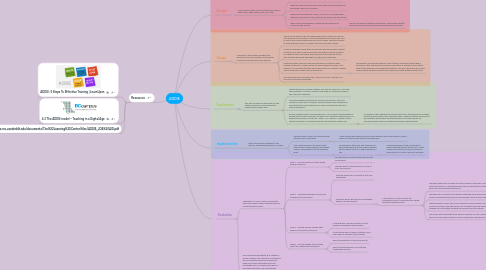
1. Resources
1.1. ADDIE: 5 Steps To Effective Training | LearnUpon
1.2. 4.3 The ADDIE model – Teaching in a Digital Age
1.3. https://www.mc.vanderbilt.edu/documents/The%20Learning%20Center/files/ADDIE_JOB%20AID.pdf
2. Analyze
2.1. With a training topic in mind, answer key aspects about Who, What, Where, Why, and How.
2.1.1. Who needs this training? Are they the consumer or end user? Who will be affected by the training topic?
2.1.2. What does the training need to cover specifically? What skills or knowledge needs to be shared?
2.1.3. Where will the training be: online, in person, or a combination? Where will the resources and materials be housed for the learner?
2.1.4. Why is the training needed? Should this be offered in an official training format?
2.1.4.1. How will the skills be taught and analyzed? How will the training show to be effective at transferring knowledge to the learner?
3. Development
3.1. This step involves the prep work for the materials needed for each objective towards the training's goal.
3.1.1. What materials are already created? Can they be used as is or do they need updates? Are they currently being used for a different purpose and cannot be changed?
3.1.2. Does the audience have time for an hour long activity? Does the content fit that style of activity? Does the learner have background noise that would make listening to a video or eLearning difficult to retain information?
3.1.3. Be sure content doesn't overlap but build. If an in-person training shows a PowerPoint to teach a process, but there is an activity for that process in a testing environment, use the tell - show - do - practice - review order to utilize the activity in a different way than the tell/show PowerPoint.
3.1.3.1. For example, the Powerpoint would be used to tell the differences between old and new processes, then show the steps. Using the testing environment, the facilitator would show the new process and let the learners try. Discussion would allow for further learning and understanding.
4. Evaluation
4.1. Kirkpatrick's 4-Level Model of Evaluation should be used to assess the effectiveness of the training program.
4.1.1. Level 1 - Was the reaction to the training program positive?
4.1.1.1. Was the learner confident they retained the information?
4.1.1.2. Was the learner stressed before, during, or after the training?
4.1.2. Level 2 - Was the knowledge successfully transferred to the learner?
4.1.2.1. Was the assessment accurate to test new knowledge?
4.1.2.2. Did every learner get the same knowledge check or section wrong?
4.1.2.2.1. If the learner isn't able to pass the knowledge checks, troubleshoot by asking what the challenges were.
4.1.3. Level 3 - Did the learners change their behavior to reflect the training?
4.1.3.1. If training was a process change, are the learners following the new process?
4.1.3.2. If the training was to reduce mistakes, does data report a change in that mistake?
4.1.4. Level 4 - Did the change from training affect the organization positively?
4.1.4.1. Were the objectives of the training met?
4.1.4.2. Were the training goals in line with the organization's goals?
4.2. Peer review should happen at all stages of ADDIE, however this last piece of reviewing the final material should be reviewed by people of various applicable skills and knowledge level. If someone who has no idea about the topic can complete the training's goal, then it can be deamed effective.
5. Design
5.1. The goals of the training is divided into objectives and skills needed for the learner to perform the outcome of the training.
5.1.1. Chunk the content by skill set needed and process order. Be sure the skills develop on each other, such as teaching the vocabulary and skills to use an oven before teaching how to broil a steak. The learner needs to know that the broiler is located in the oven and how it works.
5.1.2. Create a facilitator's guide that corresponds with the chunked content. Activities, time spent, and assessment instruments should be listed in an organized way. Any trainer should be able to pick this up and be able to guide the learner through the materials and activities.
5.1.3. Determine where resources should be housed for reference after training. Electronic or paper references have different pros and cons, however it is important that the learner has access to content to answer future questions on their own by reviewing it.
5.1.3.1. For example, the training materials could include a test environment with a document. Then that document and key information is housed/cloud location with a team dedicated to updating the material. This way, the learner has a new location going forward for resources instead of possibly dated training notes.
5.1.4. Peer review should accompany this, not just for flow of content, but accuracy of content and design.
6. Implementation
6.1. Deliver the training materials to the learners, providing assistance as needed.
6.1.1. Flexibility with content to match how the learners learn is important.
6.1.1.1. If the training was offered online, but the learners need more guidance, then a trainer-led training may need to be developed.
6.1.2. Peer review should occur here for the effectiveness of the material, knowledge checks, and adherence to the training's goals.
6.1.2.1. Sometimes by this point, the material may have drifted away from the original training goal to pigeon-hole on a single objective or skill.
6.1.2.1.1. Having leadership review, including the leaders that the learners report up to, helps to keep the training on track and gives an opportunity for content accuracy changes.

